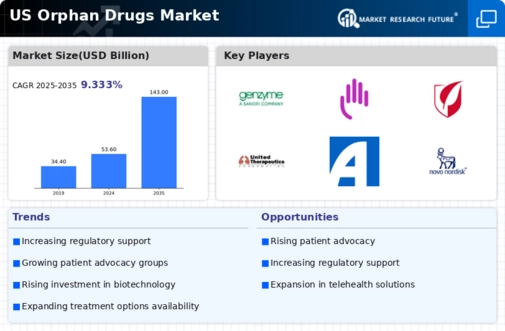Growing Patient Advocacy Groups
The orphan drugs market is increasingly influenced by the emergence of patient advocacy groups in the US. These organizations play a crucial role in raising awareness about rare diseases and advocating for the development of effective treatments. They often collaborate with pharmaceutical companies to facilitate clinical trials and provide valuable insights into patient needs. The presence of these groups has been linked to a 25% increase in the number of orphan drug applications submitted to the FDA over the past five years. Their efforts not only enhance the visibility of rare diseases but also foster a supportive environment for innovation in the orphan drugs market. As patient voices become more prominent, the demand for tailored therapies is expected to rise, further propelling market growth.
Increasing Prevalence of Rare Diseases
The orphan drugs market is experiencing growth due to the rising prevalence of rare diseases in the US. It is estimated that approximately 7,000 rare diseases affect around 30 million individuals in the country. This growing patient population creates a substantial demand for effective treatments, thereby driving the orphan drugs market. As more diseases are identified and classified as rare, pharmaceutical companies are increasingly motivated to develop targeted therapies. The orphan drugs market is projected to reach $200 billion by 2026, reflecting a compound annual growth rate (CAGR) of 10% from 2021 to 2026. This trend indicates a robust market potential, as stakeholders recognize the need for innovative solutions to address unmet medical needs.
Enhanced Research and Development Funding
In the US, the orphan drugs market benefits from increased funding for research and development (R&D) initiatives. Government programs and private investments are focusing on rare diseases, leading to a surge in clinical trials and innovative therapies. The National Institutes of Health (NIH) has allocated significant resources to support research in this area, with funding exceeding $1 billion annually for rare diseases. This financial backing encourages pharmaceutical companies to invest in the orphan drugs market, as the potential for successful drug development becomes more viable. Furthermore, the Orphan Drug Act provides incentives such as tax credits and extended market exclusivity, which further stimulate R&D efforts. As a result, the market is likely to see a continuous influx of novel therapies aimed at rare conditions.
Regulatory Framework and Fast-Track Approvals
The orphan drugs market is significantly shaped by the regulatory framework in the US, particularly the FDA's commitment to expediting the approval process for orphan drugs. The Orphan Drug Act provides various incentives, including fast-track designations and priority review, which can reduce the time to market for new therapies. This regulatory support has led to a notable increase in the number of orphan drugs approved, with over 400 new therapies receiving FDA approval in the last decade. The streamlined approval process not only encourages pharmaceutical companies to invest in the orphan drugs market but also ensures that patients gain timely access to essential treatments. As regulatory bodies continue to prioritize rare diseases, the market is likely to expand further.
Technological Innovations in Drug Development
The orphan drugs market is benefiting from technological innovations that enhance drug development processes. Advances in genomics, bioinformatics, and personalized medicine are enabling researchers to identify potential therapeutic targets more efficiently. For instance, the use of CRISPR technology and other gene-editing tools has shown promise in developing treatments for genetic disorders. The market is projected to grow as these technologies become more integrated into the drug development pipeline. It is estimated that the adoption of innovative technologies could reduce development costs by up to 30%, making it more feasible for companies to pursue orphan drug development. As a result, the orphan drugs market is likely to see an influx of novel therapies that address previously untreatable conditions.






















Leave a Comment